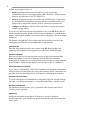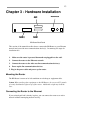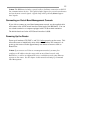
11
Adapter, or T1 CSU/DSU. Which of these devices you use depends on the type of
telco line you are connecting one of the router’s wide area interfaces to.
v Note: Before attempting to connect the BR Router to a leased telco line, use the
loopback features of your CSU/DSU’s to check the line. This can save you a
considerable amount of time, since the more equipment you have on the line, the
more difficult it becomes to determine where a problem is occurring.
The BR Router provides one high-speed V.35 synchronous interface, and one RS-
232 sync/async interface, each of which can be independently configured for PPP or
Frame Relay operation. The V.35 interface is capable of communicating to another
router or a PPP client machine over a 56K CSU/DSU, an ISDN Terminal Adapter,
or a T1 CSU/DSU. The RS-232 interface is capable of communicating to another
router or a PPP client machine over a modem, 56K CSU/DSU, or ISDN Terminal
Adapter.
V.35 Interface
The BR Router does not include a V.35 cable. These cables are available from your
reseller, or a number of other suppliers. The BR Router has a female V.35
connector, as do virtually all line communications devices. Thus, the V.35 cable
required to connect to a line communications device will usually have male
connectors at both ends. The pinouts for this cable are shown in Appendix B.
RS-232 Interface
The BR Router includes one DB-25 to DB-25 RS-232 sync/async cable. This cable
supports RS-232 asynchronous modems, synchronous leased and switched 56K
CSU/DSU’s, and ISDN Terminal Adapters. It can also be used to connect the
router’s auxiliary interface to a PC running terminal emulation software, or to a
dumb terminal.
v Note: Please use only the supplied DB-25 cable when connecting your line
communication device to the BR Router’s RS-232 interface. The cables provided
with other equipment will generally not have the same internal connections.


















